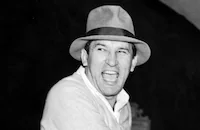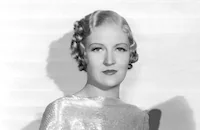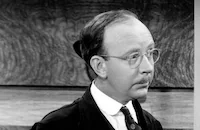Madame Du Barry

Brief Synopsis
Cast & Crew
William Dieterle
Dolores Del Rio
Reginald Owen
Victor Jory
Osgood Perkins
Verree Teasdale
Film Details
Technical Specs

Synopsis
After the death of his mistress, Madame Pompadour, Louis XV of France has no plans to fall in love again. When the Duc de Richelieu introduces him to Madame Du Barry, however, he becomes madly infatuated with her. She orders him around, enraging the court with her extravagant demands. On one hot summer day, she requests a sleigh ride, and Louis' minions empty Paris of all its sugar in order to provide "snow" for her pleasure. Only the Duc d'Aiquillon has the courage to criticize these extravagances, telling Louis stories of the poverty and unrest in France. The Duc de Choiseul, the Prime Minister of France, tries to convince Louis to form an alliance with Spain against England. Interrupting Choiseul's speech, Du Barry demands to be presented at court. Choiseul's sister, the Duchess de Grammont, persuades the king's daughters to forbid any noblewoman to sponsor Du Barry at court. When Richelieu finds a drunken countess to act as her godmother, Choiseul has her wig and gown stolen. Not to be outdone, Du Barry appears in court in her nightgown. Louis is too stunned to act, but d'Aiquillon offers her his arm, winning an ally to his cause. To avenge herself, Du Barry invites Choiseul to her room, pretending when the king arrives, that he attacked her. Choiseul is disgraced and d'Aiquillon is named prime minister, thereby averting war with England. When Marie Antoinette arrives to marry the Dauphin, Louis asks Du Barry to talk to his son about sex. This leads to an argument between Du Barry and Marie, who demands that Du Barry be expelled from court. The trouble upsets Louis so much that he falls ill. Du Barry nurses him through his illness, but is imprisoned in an abbey when he dies and the Dauphin becomes king.

Director

William Dieterle
Cast

Dolores Del Rio

Reginald Owen

Victor Jory

Osgood Perkins

Verree Teasdale
Ferdinand Gottschalk

Anita Louise
Maynard Holmes

Henry O'neill

Hobart Cavanaugh

Dorothy Tree
Virginia Sale
Camille Rovelle
Helen Lowell
Joan Wheeler

Halliwell Hobbes

Nella Walker

Arthur Treacher
Jesse Scott
Leo White

Doris Lloyd
Mary Kornman
Crew
Henry Blanke
Edward Chodorov
Clarence Enrest
F. Flanagan
Leo F. Forbstein
Bert Friend
Al Green
Herbert Levy
Harold Noyes
Jack Okey
Orry-kelly
Sol Polito
Albertina Rasch Dancers
Daniel Reed
C. A. Riggs
Fred Terzo
Homer Van Pelt
Jack L. Warner

Videos
Movie Clip


Film Details
Technical Specs

Articles
Madame du Barry (1934) - Madame Du Barry (1934)
In other words, this historical romance is presented as a fun and funny romp instead of an exercise in strained seriousness. Variety, interestingly, criticized the film for just this reason, saying, "Du Barry, as one of the world's champ courtesans, is too vivid in public mind to be treated as frothily as this."
Madame Du Barry has a lot going for it and stands up as an unjustly forgotten picture. Renowned film historian William K. Everson, in his film class program notes in the 1960s and 1970s, compared this film favorably to previous versions of the story starring Pola Negri (Madame DuBarry [1919]) and Norma Talmadge (Du Barry, Woman of Passion [1930]). Everson wrote that Negri and Talmadge "were never able to make the DuBarry story really come alive." Beautiful Dolores Del Rio, he thought, still had trouble in this regard, but the writing, camerawork, lighting, sets, music and choreography of Del Rio's version were so technically outstanding, and the supporting cast so good, that the film itself came alive like none of the others. (For the record, there was another early version of the story made in 1917 starring Theda Bara, and a foreign version would appear in 1954.)
The most-praised cast member, by Everson as well as critics in 1934, was Reginald Owen. Everson called his performance "touching," and wrote that "once one has accepted his British accent, and discarded memories of his gloriously hammed-up villains in later movies, his performance dominates the whole film -- and his superbly done death scene quite steals all the thunder from Dolores' dramatic exit." Everson also notes Anita Louise's turn as a "very bitchy" Marie Antoinette, a big contrast to Norma Shearer's regal characterization in Marie Antoinette (1938). Anita Louise, by the way, would also appear in the 1938 film, but not in the title role; instead she played a mere princess.
Also notable in Madame Du Barry is Osgood Perkins as Richelieu. Perkins was the father of actor Anthony Perkins and acted in around 20 movies from 1922-1936, including Scarface (1932).
For all the prestige films that William Dieterle directed in the late 1930s and 1940s -- The Life of Emile Zola (1937), Dr. Ehrlich's Magic Bullet (1940) and The Devil and Daniel Webster (1941) among them -- some of his best and most stylish work came in the early 1930s, in films such as The Last Flight (1931), Jewel Robbery (1932), Lawyer Man (1932), 6 Hours to Live (1932), Fog Over Frisco (1934), The Secret Bride (1934) and Madame Du Barry. William Everson went so far as to call Madame Du Barry the best movie Dieterle ever did in the period genre. "For once," wrote Everson, "here is a historical romance without a false note. Obviously, historic and dramatic license is taken, but one never notes an anachronism, no line of dialogue strikes a wrong note, no performance provokes an unintended laugh.... Occasionally theatrical -- as history sometimes has a habit of being -- this Du Barry seems to ring true, and the colorful meeting of Louis the 15th with Marie Antoinette -- on a country road as opposed to the dramatic courtroom encounter in the MGM film -- is a fine sequence. Even the occasional dry racial humors seem to belong more to French history than to Hollywood of the '30s."
Madame Du Barry was condemned by the Legion of Decency for its risqué approach to the story and dialogue. In fact, a famous scene of Du Barry appearing at court in a negligee was often missing when the film ran on television for decades afterwards.
Director: William Dieterle
Screenplay: Edward Chodorov (screenplay and story)
Cinematography: Sol Polito
Art Direction: Jack Okey
Music: Heinz Roemheld (uncredited)
Film Editing: Herbert Levy
Cast: Dolores del Rio (Madame Du Barry), Reginald Owen (King Louis XV), Victor Jory (Duc Armand d'Aiguillon), Osgood Perkins (Duc de Richelieu), Verree Teasdale (Duchess de Granmont), Ferdinand Gottschalk (Lebel), Anita Louise (Marie Antoinette), Maynard Holmes (The Dauphin), Henry O'Neill (Duc de Choiseul), Hobart Cavanaugh (Professor de la Vauguyon).
BW-79m.
by Jeremy Arnold

Madame du Barry (1934) - Madame Du Barry (1934)
Quotes
Trivia
The movie was placed on the Catholic Church's "condemned list."
Extra guards were posted on the set to watch over the valuable jewelry and antiques used in the film.
Notes
The Albertina Rasch dancers were on loan from M-G-M. Although she had a major role in Warner Bros. earlier 1934 film, Wonder Bar, this was Del Rio's first starring role for the studio. According to Daily Variety, the film was placed on the Catholic Church's "condemned" list. Guards were posted on the set to watch over the collection of valuable antiques, silver, porcelain and objets d'art used on the set. Among the many films based on the life of Du Barry are: the 1915 George Kleine film, Du Barry, starring Mrs. Leslie Carter and directed by Edoardo Bencivenga; the 1917 Fox film, Du Barry, starring Theda Bara and directed by J. Gordon Edwards (see AFI Catalog of Feature Films, 1911-20; F1.1114 and F1.1115); the 1919 German production, Madame Du Barry (titled Passion in the United States), starring Pola Negri and Emil Jannings and directed by Ernst Lubitsch; the 1930 United Artists release, Du Barry, Woman of Passion, starring Norma Talmadge and directed by Sam Taylor (see AFI Catalog of Feature Films, 1921-30; F2.1464); and the 1954 French-Italian co-production, Madame Du Barry, starring Martine Carol and directed by Christian-Jacque.














